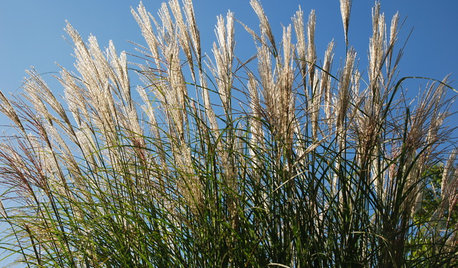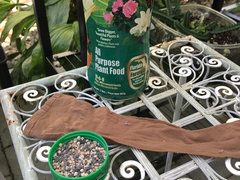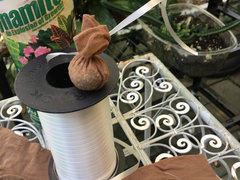Help with fertilizer and bug control in Florida
justcallmeoli
6 years ago
Featured Answer
Sort by:Oldest
Comments (32)
User
6 years agojustcallmeoli
6 years agoRelated Discussions
chemical fertilizer =) more potato bugs?
Comments (29)CPBs are a mystery to me, one year there are none and the next they go hog wild. Some years I have ladybugs out earlier than others relative to the CPB but don't see much correlation to the severity of the CPB problems from year to year. too bad I can't turn the chickens loose in the spuds, they'd do more damage than the CPBs. Dr. Whitney Cranshaw from CSU once explained to me an insect that they have problems with on tomato along the Front Range of CO. The appearance of the insects had everything to do with south winds at a certain time of the spring or early summer, no winds, no problem that year. Sorry, can't remember the insect. As far as educating people about any growing method I TRY to shut up unless asked and watch for responses both verbal and non before proceeding. You can lead a horse to water you know. Ever try to force a horse to drink? Why try knowing what the result may be. The modern organic movement is still very new with relatively little empiric testing to serve as it's foundation but there is an enormous amount of anecdotal evidence. That is not to say it has no merit, it most certainly does and deserves study. Until organic has a broader, more solid foundation I cannot preach to anyone as to it's superiority over conventional practices. However, if I find something that works or find that someone has I'm happy to try it myself or share the information. My fruit orcharding is in the slow process of converting, hopefully to completely organic, It will take time as there can be severe disease and insect pressures and I make mistakes. And then there is the weather....See Moreorganic chinch bug and weed control?
Comments (1)Switching to an organic gardening program is more than simply switching brands of fertilizer. Start by having a good, reliable soil test done and dig into your soil to see what you have nad what needs to be done to make that soil into something good and healthy that will grow strong and healthy plants that can withstand an insect infestation better and will crowd out any "weeds" growing in that same soil....See MoreWhat is your organic bugs control experience?
Comments (14)Keep in mind that organic growing is, or should be, more about learning about these insect pests and how to grow plants that are less susceptible to them than about which poisons to use to control them. That starts with a good healthy soil that will grow strong and healthy plants. Aphids are attracted to plants that have too lush growth, usually because of too much soil Nitrogen. Purchasing Lady Beetles pro9bqbly is not a good idea since experience has shown they fly away almost as soon as they are released, they are in a reproductive pause mode, and may introduce unwanted diseases into the environment they are released in. Companion planting can help, almost as much as having a good healthy soil. kimmq is kimmsr...See MoreBorax to control bugs
Comments (7)Do you mean inside the home? We've used the ant traps that have a boric acid component. They work okay, but I'd rather use a Spinosad ant bait outdoors. Outdoors? In the garden? Never, never, never, never have used it and never, never, never, never ever will. Borax is tricky to use in a garden setting. It is OMRI-approved as a soil fertilizer type additive but ONLY if a soil test shows a boron deficiency in the soil. There is a really, really fine line between having soil that has adequate boron (or that has a boron deficiency) and soil that has enough boron to become toxic to plants. I believe the difference is only a few parts per million, so you can accidentally cross that line very easily. If you use too much borax for any purpose in your garden plot or fields, you can poison your soil so that nothing will grow. Plants take up boron from the soil, and if you have excess boron in your soil (either from borax or boric acid), the plants can take up enough for it to be toxic to them. It is very easy for a person to poison their soil by using too much borax or boric acid, and then soil remediation becomes essential if the soil is ever to be suitable for growing plants again. There are many variables involved in how much boron accumulates in the soil, and it is dependant to some extent on soil pH, how well the soil does or doesn't drain, and rainfall amounts. This topic comes up regularly here on the various GW forums, often in the Organic or Soil, Compost & Mulch Forums, and sometimes in the form of questions like "Help! I added Mule Team Borax to my garden and now nothing will grow.....". My favorite thread on borax is a very long one from long ago. Let me see if I can find it and link it. If there is no link below (grin), then I didn't find it. Old Thread on Boric Acid/Borax/Boron...See MoreUser
6 years agoshavedmonkey (Harvey in South Fl.)Z10b
6 years agolast modified: 6 years agojane__ny
6 years agojustcallmeoli
6 years agojustcallmeoli
6 years agoshavedmonkey (Harvey in South Fl.)Z10b
6 years agotropicbreezent
6 years agojustcallmeoli
6 years agoshavedmonkey (Harvey in South Fl.)Z10b
6 years agolast modified: 6 years agotropicbreezent
6 years agojustcallmeoli
6 years agoshavedmonkey (Harvey in South Fl.)Z10b
6 years agotropicbreezent
6 years agoshavedmonkey (Harvey in South Fl.)Z10b
6 years agotropicbreezent
6 years agoshavedmonkey (Harvey in South Fl.)Z10b
6 years agojustcallmeoli
6 years agojane__ny
6 years agotropicbreezent
6 years agoshavedmonkey (Harvey in South Fl.)Z10b
6 years agojustcallmeoli
6 years agojane__ny
6 years agojustcallmeoli
6 years agojane__ny
6 years agojustcallmeoli
6 years agojustcallmeoli
6 years agoshavedmonkey (Harvey in South Fl.)Z10b
6 years agojane__ny
6 years agoshavedmonkey (Harvey in South Fl.)Z10b
6 years ago
Related Stories

GARDENING GUIDESGet on a Composting Kick (Hello, Free Fertilizer!)
Quit shelling out for pricey substitutes that aren’t even as good. Here’s how to give your soil the best while lightening your trash load
Full Story
GARDENING AND LANDSCAPINGBid Bad Garden Bugs Goodbye and Usher In the Good
Give ants their marching orders and send mosquitoes moseying, while creating a garden that draws pollinators and helpful eaters
Full Story
GARDENING AND LANDSCAPINGPorch Life: Banish the Bugs
Don't let insects be the bane of your sweet tea and swing time. These screening and product ideas will help keep bugs at bay on the porch
Full Story
LIFEConsider Avoiding These Plants to Help Keep Your Garden Fire-Safe
Plants that accumulate dead material, are high in oil or have low moisture content in leaves put some homes at risk
Full Story
PETSHow to Help Your Dog Be a Good Neighbor
Good fences certainly help, but be sure to introduce your pup to the neighbors and check in from time to time
Full Story
GARDENING AND LANDSCAPINGBreezy and Bug-Free Modern Porches
Screening keeps pests out of these diverse porches across the U.S., while thoughtful designs keep them visually appealing
Full Story
PETS6 Ways to Help Your Dog and Landscape Play Nicely Together
Keep your prized plantings intact and your dog happy too, with this wisdom from an expert gardener and dog guardian
Full Story
ORGANIZINGGet the Organizing Help You Need (Finally!)
Imagine having your closet whipped into shape by someone else. That’s the power of working with a pro
Full Story
LANDSCAPE DESIGNErosion Control for Your Seaside Garden
Learn how to protect the soil and plants on your shoreline for a beach landscape that lasts
Full Story
SELLING YOUR HOUSE10 Low-Cost Tweaks to Help Your Home Sell
Put these inexpensive but invaluable fixes on your to-do list before you put your home on the market
Full Story









jane__ny